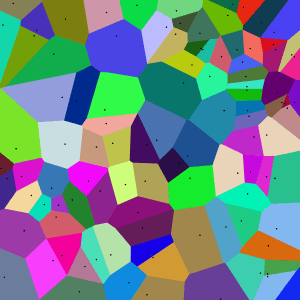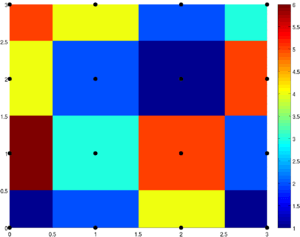Nearest-neighbor interpolation facts for kids
Imagine you have some information, like temperatures measured at different places. What if you want to know the temperature somewhere you haven't measured? That's where interpolation comes in! It's a smart way to guess values in between the points you already know.
Nearest-neighbor interpolation is one of the simplest ways to do this. The main idea is super straightforward: when you need to find a value for a new spot, you just look for the closest known spot and use its value. It's like saying, "If you want to know the temperature here, just ask the person standing closest to you what their temperature is!" This method is also sometimes called proximal interpolation or point sampling.
Contents
What is Nearest-Neighbor Interpolation?
Nearest-neighbor interpolation is a basic method used in mathematics and computer science. It helps us estimate values for places where we don't have exact data. It works by finding the single closest data point to the spot you're interested in. Then, it simply uses the value of that closest point.
Think of it like this: if you have a map with only a few cities marked with their exact elevation, and you want to know the elevation of a small town not marked, nearest-neighbor interpolation would tell you to use the elevation of the closest city on your map. It doesn't try to blend values or make smooth changes. It just picks the nearest one.
How Does It Work?
The process of nearest-neighbor interpolation is quite simple and fast. Here's how it generally works:
- Step 1: Find your spot. You pick a new location or point where you want to know a value.
- Step 2: Look for neighbors. The computer then searches through all the known data points. It calculates the distance from your new spot to every known data point.
- Step 3: Pick the closest. It identifies which of the known data points is the absolute closest to your new spot.
- Step 4: Use its value. The value from that closest known data point is then assigned to your new spot.
For example, if you have a picture made of tiny squares called pixels, and you want to make the picture bigger, nearest-neighbor interpolation would create new pixels. For each new pixel, it would just copy the color from the closest original pixel. This makes the image look blocky, but it's very quick to do.
Where Is It Used?
Even though it's simple, nearest-neighbor interpolation is used in many different areas:
- Image Scaling: When you make a digital picture bigger or smaller, this method can be used. It's fast, but it can make images look jagged or "pixelated."
- Computer Graphics: In video games or 3D modeling, it helps decide how textures (like patterns on a wall) appear on objects.
- Geographic Information Systems (GIS): When creating maps, it can be used to estimate values like rainfall or temperature in areas where data wasn't directly collected. It uses data from the nearest weather station, for example.
- Data Analysis: Sometimes, if you have missing data points in a set, you can use this method to fill them in quickly.
Good Points and Not-So-Good Points
Like any tool, nearest-neighbor interpolation has its strengths and weaknesses.
Good Points
- Simple and Fast: It's very easy for computers to do, which means it's super quick. This is great for real-time applications like video games.
- No New Values: It only uses values that already exist. It doesn't create any "in-between" values that might not make sense.
- Preserves Sharp Edges: In images, it can keep sharp lines and details from blurring, unlike some other methods.
Not-So-Good Points
- Blocky Results: Because it just copies values, the results can look "blocky" or "jagged," especially when scaling images.
- Sudden Changes: The values can change very suddenly from one point to another. This is because as soon as you cross the boundary to a new "closest point," the value instantly switches.
- Not Smooth: It doesn't create a smooth transition between known data points. This might not be ideal for things like temperature maps where you expect gradual changes.
Even with its downsides, nearest-neighbor interpolation is a fundamental concept in many digital processes because of its speed and simplicity. It's a great example of how a simple idea can be very useful!
See also
In Spanish: Interpolación por el vecino más cercano para niños



